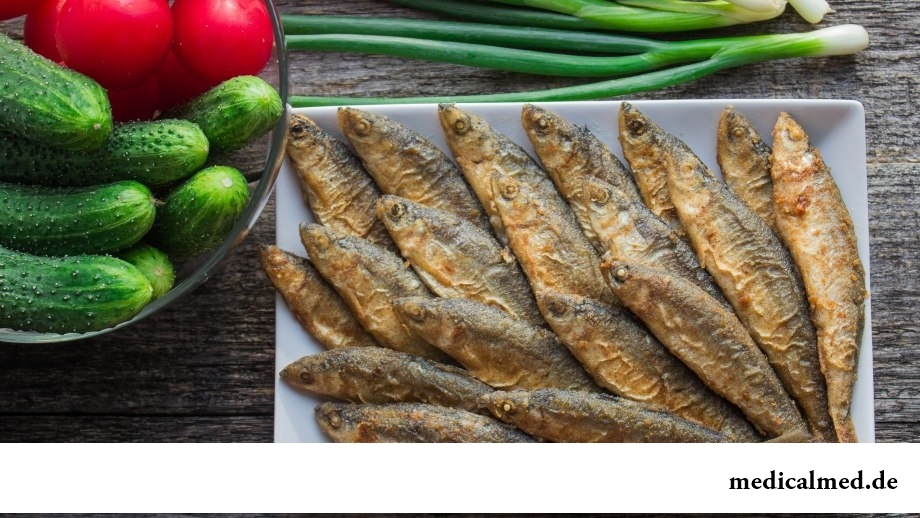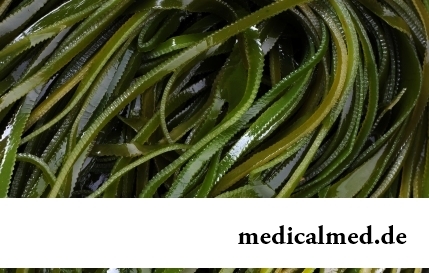





Ryapushka
Ryapushka is fresh-water fish from family Salmon. Kinds of a ryapushka: European, Siberian and coregonus albula which in our country is known also as "pereslavsky herring" though to сельдям it has no relation unless it is externally a little similar.

Description
The size of a ryapushka makes 13-20 centimeters. Especially jumbos can reach 35 centimeters in length. In a form the ryapushka externally resembles a herring, her body is compressed on each side, the upper jaw is shorter lower, and at a mandible there is a dredging. The body of fish is covered with large scales, sides the silvery color, a back – gray-blue have, a belly – white. Fins at fish of white color, except a back and tail fin, which gray color.
Features of dwelling of a ryapushka
Ryapushka prefers to live in cold northern waters. Therefore in Russia she can be met preferential in big lakes, such as Onega, Ladoga, White, Pleshcheevo, Chudskoye, Pskov. Sometimes she meets in the rivers, and lives in Botnichesky and Finnish gulfs of the Baltic Sea.
Ryapushka prefers deep areas with a clay or sandy bottom. Fish avoids shallow water and warm water. In addition to Russia, it is possible to meet a ryapushka in Scotland, Denmark, Belarus, Germany, Scandinavia, Finland.
Fish eats generally small Crustacea (a Cyclops, water fleas, etc.). To get livelihood, a ryapushka often packs comes up on small depth.
Spawning at fish begins late fall or in the early winter. In northern lakes fish spawns a little earlier – at the beginning of September, and in Chudsky and Pleshcheevsky lakes – from the middle of November on the middle of December. Caviar at a ryapushka small and in the diameter makes only 1,5 millimeters, but, at the same time, quite numerous – 3600 berries at females. Productive capacity at fish appears on the second year of life when its sizes reach about 7 centimeters.
The angriest enemy of a ryapushka in nature is the stickle-back which eats young growth and caviar of this fish.
Despite the small sizes, the ryapushka is a valuable subject of fishing trade. Preparation of a ryapushka is possible practically in any kind – fried, smoked, salty. Caviar of fish is considered also valuable food stuff.
Catch a ryapushka by means of seines of various design, and fish comes across a hook very seldom. Fish is in Russia on the verge of disappearance in connection with mass illegal catch, but in Germany it is parted in special reservoirs.
Structure and caloric content of a ryapushka
Fish contains water, proteins and fats, and also mineral substances: fluorine, magnesium, zinc, phosphorus, nickel, histidine, calcium, chrome, chlorine, molybdenum; RR vitamin.
Ryapushka meat richly in an omega-3 acids, and also calcium and phosphorus. In such combination digestion of calcium happens to the best return for an organism.
One more important advantage of a ryapushka is the high content of magnesium (175 mg on 100 g of a product).
In comparison with other fishes of fresh waters quite low also makes ryapushka caloric content to 78 kcal on 100 g of a product. Therefore use of a ryapushka perfectly will be suitable for the dietary menu.
Advantage and properties of a ryapushka
As it was already mentioned above, as a part of a ryapushka there are polyunsaturated fatty acids an omega-3 which have property quickly to break up therefore fish is perishable good. A period of storage freshen should not exceed ryapushka one days, and to store it better in ice.
At 15-18 centuries the ryapushka was the privilege of an imperial table, dish from it even were an integral part of a ritual of a crowning on a kingdom or on the Moscow principality. And, however, nutritious properties of a ryapushka provided good nutrition to muscles and heart, and also brain cells. A combination in meat of fish of such elements as the histidine and magnesium, stimulate work of nervous and immune systems.
And that fish was possible to be transported on long distances, she is subjected to deep freezing that allows to keep its useful qualities for long term. The small sizes of fish are with interest compensated by the small number of bones – no more than 9%. All useful and nutritious properties of fish remain even at a pickles or smoking.
Ways of preparation of a ryapushka
There are most various ways of preparation of a ryapushka. It is appreciated in a smoked, salty, fresh look. From it it is possible to prepare such dishes as "A sprat house of a ryapushka", "marinated Ryapushka", "Ryapushka fried with sour cream", etc.
This fish is the cornerstone of a traditional Finnish dish – pie which is cooked from the fresh fried test.
And here one of ways of preparation of a ryapushka: fish carefully to wash up, skin with it and to allow water to flow down. To lay out fish in a saucepan, to scald boiled water and to cook some time, periodically stirring slowly. When fish cooks, to cool her. At this time to prepare gas station from bay leaf, the vinegar which is small cut some horse-radish and salt (all components need to be boiled). To shift fish in pure capacity and to powder with fennel, bay leaf, allspice, to fill in from above with gas station and to allow to infuse several days. When fish well becomes impregnated with vinegar, to press down her oppression and to insist two more weeks.

The interesting facts about a ryapushka
On a municipal coat of arms Pereslavl-Zalessky flaunts a smoked ryapushka.
Ryapushka who lives in the Pleshcheevsky lake was included into the menu of imperial persons earlier and made a part of a coronation lunch. Especially large and fat fish whom it was impossible to catch and sell was found in this lake. In case of disobedience hunters of fish were threatened by the death penalty.
The most favourite fish of Finns – a ryapushka which can be prepared on each street festival, previously having rolled in in flour. Fry it on repp Finnish oil with addition of creamy.
In the aspiration to pull out the patient, doctors often go too far. So, for example, a certain Charles Janszen during the period from 1954 to 1994 endured more than 900 operations on removal of new growths.

Extracorporal fertilization – one of the most modern methods of controlling with infertility. So far it already helped znach...
Section: Articles about health
Statistically, in Russia about 34% of citizens smoke. Most of consumers of tobacco has problems with health sooner or later. Not only smokers, but also their relatives suffer. Besides, cigarettes are expensive, and need of their acquisition heavy bry...
Section: Articles about health
Shops of household appliances offer us the huge choice of various devices for the house. Whether there are among this abundance devices which not only facilitate house work, but also help to keep health of the person? Of course, and we will tell about them today....
Section: Articles about health
All got used long ago that, having addressed the plastic surgeon, it is possible to modify natural parameters of a figure or to reduce...
Section: Articles about health
Health and attractiveness - eternal values, pursuing which people often use the most unusual ingredients and technicians. Let's consider 11 most exotic and sometimes not most pleasant Spa procedures to which the person in a pursuit for beauty agrees...
Section: Articles about health
Several decades ago the basil (the district khan, реан, Reagan) was considered as a part of the Caucasian or east cuisine, but today it strongly took the place on tables of Russians. Greens of this plant possess a strong, pleasant smell and specific fresh taste because of which it is included almost in all dry mixes of spicy herbs, and also give to meat and fresh fish dishes....
Section: Articles about health
Cold is such painful that each sigh becomes a victory, heat "knocks" down, and the ache in joints forces to think only about...
Section: Articles about health
The thought that the mass of their body is too big at least once in life visits from 80 to 95% of women. Many women are so obsessed with this idea that constantly try all new and new ways of weight reduction. Considerable part of these method...
Section: Articles about health
Diseases of joints often begin imperceptibly for the person. The first stages of destruction of the cartilaginous tissue providing soft and free sliding of heads of bones in joint bags proceed slowly and absolutely without serious consequences. Especially unpleasantly for the fact that this process is not connected with advanced age: degradation of joint surfaces is, as a rule, noticeable after 30 years. It means that practically each able-bodied person at any time can face sad results...
Section: Articles about health
Milk and products of its processing by right occupy one of the main places in a diet of the modern person. They contain necessary...
Section: Articles about health
The state of health of the person in many respects depends on chemical composition of biological liquids of an organism. Specialists consider that PH value of these solutions has to be in range of 7,35-7, 45. A deviation in the smaller party (so-called "acidulation") to a chra...
Section: Articles about health
Tea is loved and use almost everything. This drink has tonic properties, contains the tannins capable to suppress activity of causative organisms. Recently great popularity was gained by teas with vegetable additives. The medicative herbs, spices and fruit which are a part of such mixes enrich drink with vitamins and microelements, increasing its nutritional value and creating additional curative effect....
Section: Articles about health
Ayurveda - the most ancient tselitelsky practice which came to us from India. It represents the doctrine about maintenance physical, ps...
Section: Articles about health
All know that self-treatment is dangerous. However absolutely it is almost impossible to do without it. Rate of modern life does not allow to handle each small trouble to the doctor and information on ways of independent rendering medical the help...
Section: Articles about health
Phobia – the persuasive fear of a certain contents shown in a specific situation against the will of the person. Concepts of a phobia and fear are similar, however if the fear is natural protective function of mentality, then the phobia is its deviation. So the person can feel the unaccountable, baseless fear accompanied with neurotic symptoms (perspiration, a shiver, a fever) before any ordinary phenomenon – for example, a trip by the subway or a simple dog....
Section: Articles about health
The sclera and mucous membrane of an eye are intensively supplied with blood vessels which problem - to sate nervous tissues of body to a pitata...
Section: Articles about health
Mushrooms - the surprising inhabitants of our planet having a set of wonderful qualities. Thanks to one of them, a mold mushroom of Penicillium notatum, the first natural antibiotic - penicillin was received nearly 80 years ago. The mankind is obliged to this opening миллио...
Section: Articles about health
Water with a lemon - idle time in preparation drink which supporters of a healthy lifestyle already managed to appreciate. Used in a warm look and on an empty stomach, it is one of the most useful prophylactics allowing to prevent tens of diseases and just to raise an organism tone. Especially effectively to use warm water with lemon juice after a serious illness, during a season of the colds, and also to children, old men and pregnant women which do not have contraindications...
Section: Articles about health
Practice of use of table salt in the therapeutic purposes contains not one century. Appl are considered especially effective...
Section: Articles about health
Cold – a state known to everyone which is followed by cold, cough, high temperature, a pharyngalgia. Often the first that we begin to do in hope again to become healthy – to accept medicines which are not always harmless, then...
Section: Articles about health
The immunity role in growth of the child is invaluable. The proteins-immunoglobulins produced by immune system preserve the child against the diseases capable − owing to an organism weak still − to serve as a stressful factor, to become the reason of many complications and delays in development of the kid. If the immune system weakened, health of the child is under direct threat and needs active actions for strengthening of protective forces of an organism − preferably non-drug....
Section: Articles about health
It would seem, about it there can be no disagreements: water is necessary for a human body for normal zhiznedeyatet...
Section: Articles about health
The state of health of the person depends on many factors. One of the most important is the constant, but not exhausting a physical activity. In the presence of various illnesses specialists often advise patients to do swimming which by right borrows ведущ...
Section: Articles about health
For residents of the countries of Southeast Asia various algas are an obligatory component of a daily diet. Their popularity is connected not only with high tastes, but also with numerous curative properties. Russians are a little familiar with products such that is distressing: algas are so useful that they should be eaten as often as possible. Let's get acquainted closer with useful properties of this seafood....
Section: Articles about health
Eyes – unique body on the structure thanks to which the person obtains about 80% of information on the world around: about a form...
Section: Articles about health
Within several decades of our compatriots convinced that the use of butter nasty affects a condition of coronary vessels. As a result the reputation of a product was impaired thoroughly a little, and many almost ceased to include...
Section: Articles about health
The winter swimming in open reservoirs called in our country by "winter swimming" – officially recognized sport and one of the most extreme ways of a hardening of an organism. This occupation has an old story and adherents in many countries. The international competitions in winter heats on open water, and every two years – the World Cup are annually held. Despite huge popularity and the proved advantage for health, winter swimming is still surrounded with hardy delusions. Ра...
Section: Articles about health
